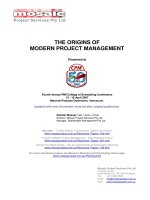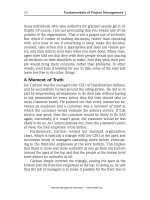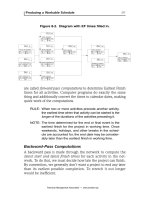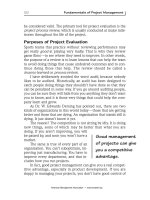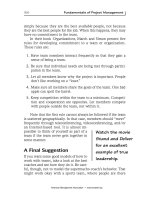Fundamentals of project management fourth edition joseph heagney
Bạn đang xem bản rút gọn của tài liệu. Xem và tải ngay bản đầy đủ của tài liệu tại đây (1.15 MB, 223 trang )
Fundamentals of
Project Management
Fourth Edition
This page intentionally left blank
Fundamentals of
Project Management
Fourth Edition
JOSEPH HEAGNEY
American Management Association
New York • Atlanta • Brussels • Chicago • Mexico City • San Francisco
Shanghai • Tokyo • Toronto • Washington, D.C.
Special discounts on bulk quantities of AMACOM books are available
to corporations, professional associations, and other organizations.
For details, contact Special Sales Department, AMACOM, a division of
American Management Association, 1601 Broadway, New York, NY 10019.
Tel: 800–250–5308. Fax: 518–891–2372.
E-mail:
Website: www.amacombooks.org/go/specialsales
To view all AMACOM titles go to: www.amacombooks.org
This publication is designed to provide accurate and authoritative information in regard to the
subject matter covered. It is sold with the understanding that the publisher is not engaged in
rendering legal, accounting, or other professional service. If legal advice or other expert assistance is required, the services of a competent professional person should be sought.
“PMI” and the PMI logo are service and trademarks of the Project Management Institute, Inc.
which are registered in the United States of America and other nations; “PMP” and the PMP
logo are certification marks of the Project Management Institute, Inc. which are registered in the
United States of America and other nations; “PMBOK”, “PM Network”, and “PMI Today” are
trademarks of the Project Management Institute, Inc. which are registered in the United States
of America and other nations; “. . . building professionalism in project management . . .” is a
trade and service mark of the Project Management Institute, Inc. which is registered in the
United States of America and other nations; and the Project Management Journal logo is a trademark of the Project Management Institute, Inc.
PMI did not participate in the development of this publication and has not reviewed the content
for accuracy. PMI does not endorse or otherwise sponsor this publication and makes no warranty,
guarantee, or representation, expressed or implied, as to its accuracy or content. PMI does not
have any financial interest in this publication, and has not contributed any financial resources.
Additionally, PMI makes no warranty, guarantee, or representation, express or implied, that the
successful completion of any activity or program, or the use of any product or publication, designed to prepare candidates for the PMP® Certification Examination, will result in the completion or satisfaction of any PMP® Certification eligibility requirement or standard.
Library of Congress Cataloging-in-Publication Data
Heagney, Joseph.
Fundamentals of project management / Joseph Heagney.—4th ed.
p. cm.
Includes bibliographical references and index.
ISBN-13: 978-0-8144-1748-5
ISBN-10: 0-8144-1748-5
1. Project management. I. Title.
HD69.P75L488 2011
658.4'04—dc22
2011012421
© 2012 American Management Association.
All rights reserved.
Printed in the United States of America.
This publication may not be reproduced, stored in a retrieval system,
or transmitted in whole or in part, in any form or by any means,
electronic, mechanical, photocopying, recording, or otherwise,
without the prior written permission of AMACOM, a division of
American Management Association, 1601 Broadway, New York, NY 10019.
Printing number
10 9 8 7 6
5
4
3
2
1
To the memory of Mackenzie Joseph Heagney,
sleeping with the angels.
This page intentionally left blank
CONTENTS
Figure List
Preface to the Fourth Edition
Acknowledgments
ix
xi
xv
Chapter 1
An Overview of Project Management
1
Chapter 2
The Role of the Project Manager
24
Chapter 3
Planning the Project
32
Chapter 4
Developing a Mission, Vision, Goals,
and Objectives for the Project
45
Chapter 5
Creating the Project Risk Plan
55
Chapter 6
Using the Work Breakdown
Structure to Plan a Project
68
Chapter 7
Scheduling Project Work
81
Chapter 8
Producing a Workable Schedule
93
Chapter 9
Project Control and Evaluation
112
Chapter 10 The Change Control Process
125
Chapter 11 Project Control Using Earned
Value Analysis
141
Chapter 12 Managing the Project Team
156
Chapter 13 The Project Manager as Leader
168
Chapter 14 How to Make Project Management
Work in Your Company
180
Answers to Chapter Questions
Index
About the Authors
185
189
201
vii
This page intentionally left blank
FIGURE LIST
1–1.
1–2.
1–3.
1–4.
Triangles showing the relationship between P, C, T, and S.
Life cycle of a troubled project.
Appropriate project life cycle.
The steps in managing a project.
3–1. Two pain curves in a project over time.
3–2. Planning is answering questions.
4–1. Chevron showing mission, vision, and problem statement.
4–2. Risk analysis example.
5–1. Risk matrix.
5–2. Risk register.
6–1.
6–2.
6–3.
6–4.
WBS diagram to clean a room.
WBS level names.
Partial WBS.
Responsibility chart.
7–1.
7–2.
7–3.
7–4.
7–5.
Bar chart.
Arrow diagrams.
WBS to do yard project.
CPM diagram for yard project.
WBS to clean room.
8–1. Network to illustrate computation methods.
8–2. Diagram with EF times filled in.
8–3. Diagram showing critical path.
ix
Figure List
x
8–4.
8–5.
8–6.
8–7.
8–8.
8–9.
Bar chart schedule for yard project.
Schedule with resources overloaded.
Schedule using float to level resources.
Schedule with inadequate float on C to permit leveling.
Schedule under resource-critical conditions.
Network for exercise.
10–1. Triple constraints triangle.
10–2. Project change control form.
10–3. Project change control log.
11–1.
11–2.
11–3.
11–4.
11–5.
11–6.
11–7.
11–8.
11–9.
BCWS curve.
Bar chart schedule illustrating cumulative spending.
Cumulative spending for the sample bar chart.
Plot showing project behind schedule and overspent.
Project ahead of schedule, spending correctly.
Project is behind schedule but spending correctly
Project is ahead of schedule and underspent.
Percentage complete curve.
Earned value report.
13–1. Leadership style and alignment.
A-1. WBS for the camping trip.
A-2. Solution to the WBS exercise.
A-3. Solution to the scheduling exercise.
Preface to the
Fourth Edition
Sending a satellite to Mars? Planning a conference or implementing new software? You have chosen the right book. The great
value of project management is that it can be applied across industries and situations alike, on multiple levels. It would be difficult to find a more nimble organizational discipline. Whether or
not your title says project manager, you can benefit from the practical applications presented in this book, which is intended as a
brief overview of the tools, techniques, and discipline of project
management as a whole. Three notable topics have been expanded for this edition, with new chapters on the project manager as leader, managing project risk, and the change control
process. Although each topic is important individually, together
they can establish the basis for project success or failure.
Projects are often accomplished by teams, teams are made up
of people, and people are driven by . . . project leaders. Conspicuously absent from the preceding is the term “manager,” as in
“project manager.” If project managers manage projects, what do
they do with the people who make up their teams or support networks in the absence of a formal team? Successful project leaders
lead the people on their teams to consistent goal attainment and
xi
xii
Preface to the Fourth Edition
enhanced performance. They combine a command of project
tools and technical savvy with a real understanding of leadership
and team performance. Consistently successful projects depend
on both. It is a balancing act of execution and skilled people management. Ignoring one or the other is inviting project failure and
organizational inconsistency regarding project performance.
Risk is an element inherent in every project. The project
manager must consider several variables when determining how
much to invest in the mitigation and management of that risk.
How experienced is my team or support personnel? Do I have
the appropriate skill sets available? Can I count on reliable data
from previous projects, or am I wandering in the wilderness?
Whatever the assessment, project risk is something that needs
to be addressed early in the life of the project. As with any other
process you will be introduced to in this book, risk must be managed formally, with little deviation from the template, while allowing for some flexibility. Project managers cannot afford to
wait for bad things to happen and then fix them. Reactive management is too costly. The practical Six-Step process presented
on pages 57–62 can and should be applied to any project. How
it is applied directly depends on the variables that confront that
project.
Death, taxes, and change. Project managers need to expand
the list of certainties in life. To paraphrase James P. Lewis, author
of the first three editions of this book, in Chapter 3, project failures
are caused primarily by the failure to plan properly. I often tell my
seminar attendees that planning is everything and that most projects succeed or fail up front. This is not an overstatement. But
what often gets lost in project execution is the absolute necessity
to keep the plan current based on the changes that have affected
the project from day one. Have the changes affected the scope of
the project? Has the schedule or budget been impacted in any significant way? These are the questions that must be asked and answered when applying effective change control to the project.
Failure to manage and communicate change results in serious misalignment and probably failure. Chapter 10 presents the reader
Preface to the Fourth Edition
xiii
with a practical change control process that can help ensure project success.
As a former Global Practice Leader for project management
at the American Management Association, I had the luxury of
benchmarking multiple organizations worldwide and identified
several project-related best practices. The applications discussed
here represent some of those practices, as well as those presented in the latest version of the PMBOK ® Guide. With this expanded edition of Fundamentals of Project Management, I hope
to enhance your chances of bringing projects in on time, on budget with an excellent deliverable—every time.
Joseph J. Heagney
Sayville, NY
February 2011
This page intentionally left blank
Acknowledgments
A special thanks to Nicolle Heagney for her technical assistance
in creating many of the figures and charts presented in the book.
Her expertise and diligence made my life a lot easier.
Thanks to Kyle Heagney for allowing me to miss some of his
soccer games.
xv
This page intentionally left blank
Fundamentals of
Project Management
Fourth Edition
This page intentionally left blank
CHAPTER 1
An Overview of
Project Management
W
hat’s all the fuss about, anyway? Since the first edition of
this book was published, in 1997, the Project Management
Institute (PMI®) has grown from a few thousand members to
nearly 450,000 in 2011. For those of you who don’t know,
PMI is the professional organization for people who manage
projects. You can get more information from the institute’s
website, www.pmi.org. In addition to providing a variety of
member services, a major objective of PMI is to advance project
management as a profession. To do so, it has established a certification process whereby qualifying individuals receive the Project Management Professional (PMP®) designation. To do so,
such individuals must have work experience (approximately five
thousand hours) and pass an online exam that is based on the
Project Management Body of Knowledge, or the PMBOK ® Guide.
A professional association? Just for project management? Isn’t
project management just a variant on general management?
Yes and no. There are a lot of similarities, but there are
enough differences to justify treating project management as a
discipline separate from general management. For one thing, projects are more schedule-intensive than most of the activities that
1
American Management Association • www.amanet.org
Fundamentals of Project Management
2
general managers handle. And the people in a project team often
don’t report directly to the project manager, whereas they do report to most general managers.
So just what is project management, and, for that matter,
what is a project? PMI defines a project
as “a temporary endeavor undertaken to
PMI defines a projproduce a unique product, service, or
ect as “. . . a temresult” (PMBOK ® Guide, Project Management Institute, 2008, p. 5). This
porary endeavor
means that a project is done only one
undertaken to
time. If it is repetitive, it’s not a project.
A project should have definite starting
produce a unique
and ending points (time), a budget
product, service,
(cost), a clearly defined scope—or magnitude—of work to be done, and specific
or result.”
performance requirements that must be
met. I say “should” because seldom does
a project conform to the desired definition. These constraints on
a project, by the way, are referred to throughout this book as
the PCTS targets.
Dr. J. M. Juran, the quality guru, also defines a project as a
problem scheduled for solution. I like this definition because it reminds me that every project is conducted
A project is a
to solve some kind of problem for a company. However, I must caution that the
problem scheduled
word “problem” typically has a negative
for solution.
meaning, and projects deal with both
positive and negative kinds of problems.
—J. M. Juran
For example, developing a new product is
a problem, but a positive one, while an environmental cleanup
project deals with a negative kind of problem.
Project Failures
In fact, the Standish Group (www.standishgroup.com) has found
that only about 17 percent of all software projects done in the
American Management Association • www.amanet.org
An Overview of Project Management
3
United States meet the original PCTS targets, 50 percent must
have the targets changed—meaning they are usually late or overspent and must have their performance requirements reduced—
and the remaining 33 percent are actually canceled. One year,
U.S. companies spent more than $250 billion on software development nationwide, so this means that $80 billion was completely lost on canceled projects. What is truly astonishing is that
83 percent of all software projects get into trouble!
Now, lest you think I am picking on software companies, let
me say that these statistics apply to many different kinds of projects. Product development, for example, shares similar dismal
rates of failure, waste, and cancellation. Experts on product development estimate that about 30 percent of the cost to develop a
new product is rework. That means that one of every three engineers assigned to a project is working full time just redoing what
two other engineers did wrong in the first place!
I also have a colleague, Bob Dudley, who has been involved
in construction projects for thirty-five years. He tells me that
these jobs also tend to have about 30 percent rework, a fact that
I found difficult to believe, because I have always thought of construction as being fairly well defined and thus easier to control
than might be the case for research projects, for example. Nevertheless, several colleagues of mine confirm Bob’s statistics.
The reason for these failures is consistently found to be inadequate project planning. People adopt a ready-fire-aim approach
in an effort to get a job done really fast and end up spending far
more time than necessary by reworking errors, recovering from
diversions down “blind alleys,” and so on.
I am frequently asked how to justify formal project management to senior managers in companies, and I always cite these statistics. However, they want to know whether using good project
management really reduces the failures and the rework, and I can
only say you will have to try it and see for yourself. If you can
achieve levels of rework of only a few percent using a seat-of-thepants approach to managing projects, then keep doing what you’re
doing! However, I don’t believe you will find this to be true.
American Management Association • www.amanet.org
Fundamentals of Project Management
4
The question I would ask is whether general management
makes a difference. If we locked up all the managers in a company
for a couple of months, would business
continue at the same levels of perforProject managemance, or would those levels decline? If
they decline, then we could argue that
ment is application
management must have been doing
of knowledge, skills,
something positive, and vice versa. I
doubt that many general managers
tools, and techwould want to say that what they do
doesn’t matter. However, we all know
niques to project
that there are effective and ineffective
activities to achieve
general managers, and this is true of project managers, as well.
project require-
What Is Project
Management?
ments. Project
management is accomplished through
the application and
integration of the
project management processes of
initiating, planning,
executing, monitoring and controlling,
and closing.
The PMBOK ® Guide definition of project management is “application of
knowledge, skills, tools, and techniques
to project activities to meet the project
requirements. Project management is accomplished through the application and
integration of the 42 logically grouped
project management processes comprising the 5 Process Groups: initiating,
planning, executing, monitoring and controlling, and closing” (PMBOK ® Guide,
Project Management Institute, 2008,
p. 6). Project requirements include the
PCTS targets mentioned previously.
The various processes of initiating,
planning, and so on are addressed later
in this chapter, and the bulk of this book is devoted to explaining how these processes are accomplished.
American Management Association • www.amanet.org
An Overview of Project Management
5
It would be better if the PMBOK ® Guide specified that a project manager should facilitate planning. One mistake made by inexperienced project managers is to plan the project for the team.
Not only do they get no buy-in to their
plan, but that plan is usually full of holes.
The first rule of
Managers can’t think of everything, their
project manageestimates of task durations are wrong,
and the entire thing falls apart after the
ment is that the
project is started. The first rule of project
people who must
management is that the people who must
do the work should help plan it.
do the work should
The role of the project manager is
help plan it.
that of an enabler. Her job is to help the
team get the work completed, to “run
interference” for the team, to get scarce resources that team
members need, and to buffer them from outside forces that
would disrupt the work. She is not a project czar. She should
be—above everything—a leader, in the true sense of the word.
The best definition of leadership that I have found is the one
by Vance Packard, in his book The Pyramid Climbers. He says,
“Leadership is the art of getting others
to want to do something that you be“Leadership is the
lieve should be done.” The operative
art of getting
word here is “want.” Dictators get others to do things that they want done. So
others to want to
do guards who supervise prison work
do something that
teams. But a leader gets people to want
to do the work, and that is a significant
you believe should
difference.
The planning, scheduling, and conbe done.”
trol of work represent the management
—Vance Packard
or administrative part of the job. But,
without leadership, projects tend to just
satisfy bare minimum requirements. With leadership, they can exceed those bare minimums. I offer a comprehensive application
of project leadership techniques in Chapter 13.
American Management Association • www.amanet.org
6
Fundamentals of Project Management
It Is Not Just Scheduling!
One of the common misconceptions about project management
is that it is just scheduling. At last report, Microsoft had sold a
huge number of copies of Microsoft Project®, yet the project failure rate remains high. Scheduling is certainly a major tool used to
manage projects, but it is not nearly as important as developing a
shared understanding of what the project is supposed to accomplish or constructing a good work breakdown structure (WBS) to
identify all the work to be done (I discuss the WBS in Chapter 6).
In fact, without practicing good project management, the only
thing a detailed schedule is going to do is allow you to document
your failures with great precision!
I do want to make one point about scheduling software. It
doesn’t matter too much which package you select, as they all have
strong and weak points. However, the tendency is to give people
the software and expect them to learn how to use it without any
training. This simply does not work. The features of scheduling
software are such that most people don’t learn the subtleties by
themselves. They don’t have the time, because they are trying to
do their regular jobs, and not everyone is good at self-paced learning. You wouldn’t hire a green person to run a complex machine
in a factory and put him to work without training, because you
know he will destroy something or injure himself. So why do it
with software?
One-Person Projects
When is managing a project not project management? When
only one person is involved.
A lot of people are sent to my seminars to learn how to manage
projects, but they are the only person working on their projects.
Now it is true that a one-person job can be called a project, because
it has a definite starting point, target, end date, specific performance requirements, defined scope of work, and a budget. However, when no one else is working on the project (including outside
vendors), there is no need for a critical path schedule. A critical
American Management Association • www.amanet.org
